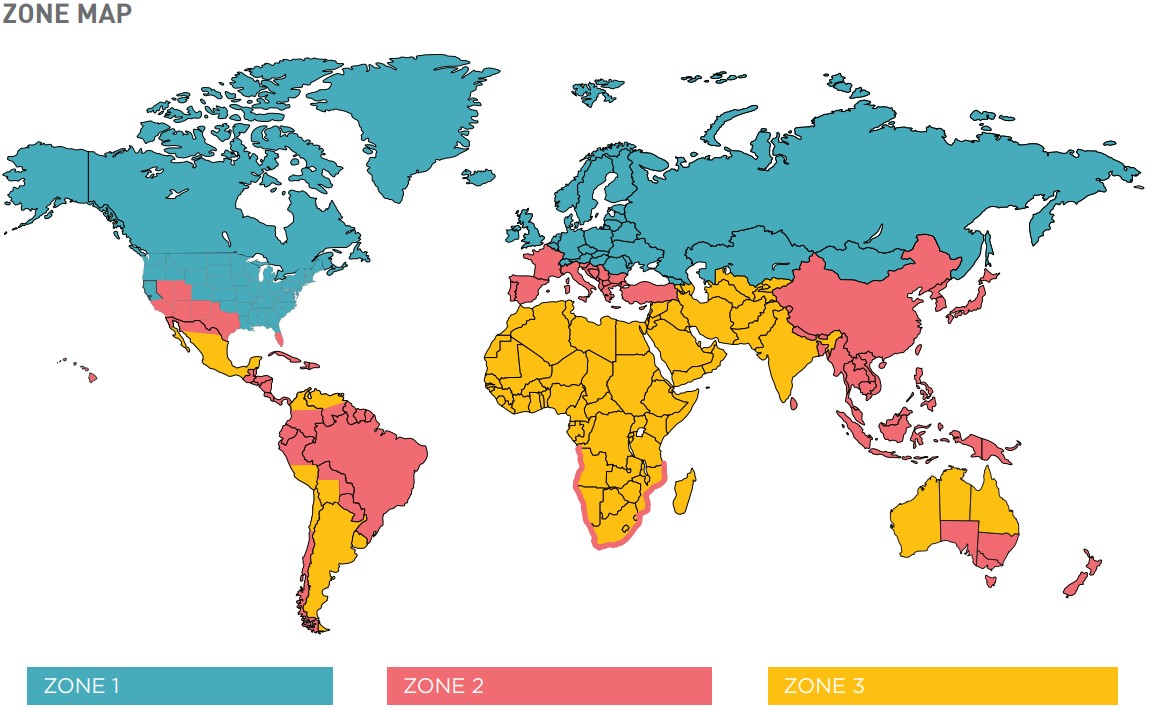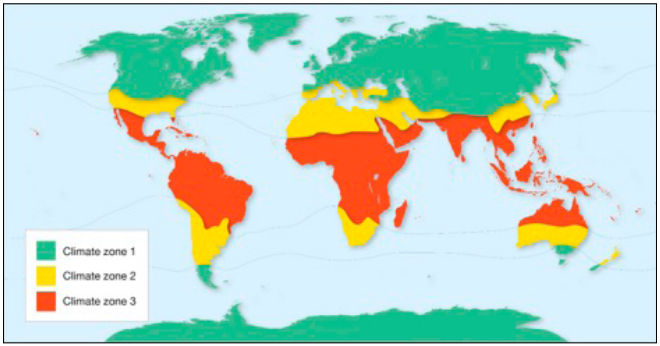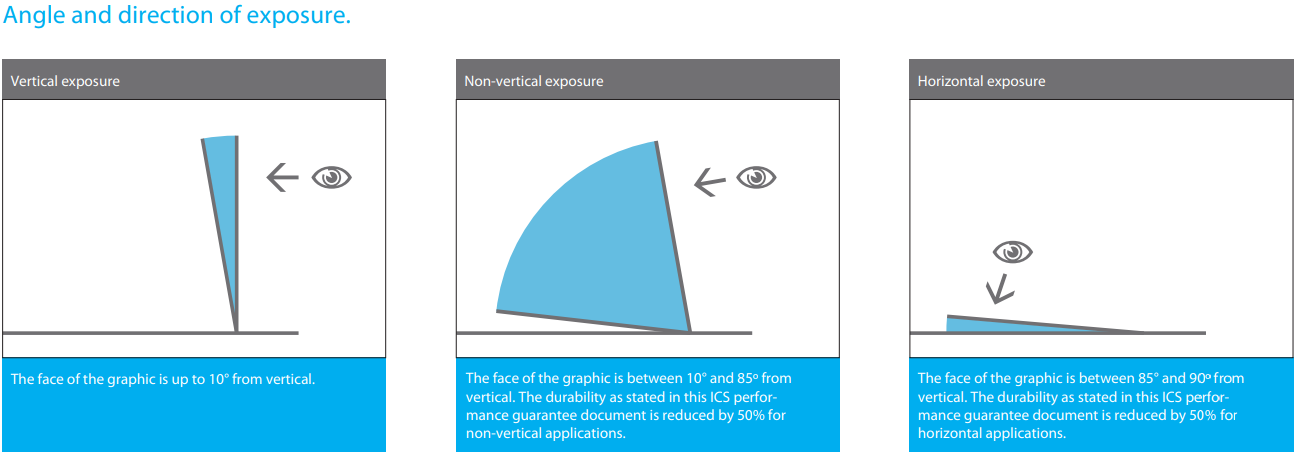You might get anywhere from 5-7 years quoted to you as the expected performance life of your vehicle wrap, but that’s just an average, the real story is a bit more complicated.
In this guide I cover every factor that can affect the durability of your vehicle wrap including, product, climate, solar radiation, angle of exposure, altitude, particulates, pollutants and aftercare.
Product
The first factor that you should keep in mind is that the expected performance life, or the durability of your vehicle wrap, will vary from product to product depending on the materials and finishes used to manufacture it.
For example Avery Supreme Wrapping Film can last anywhere from 5 to 12 years depending on colour and finish. Black & White can last up to 12 whilst a metallic finish only lasts 5.
And that’s just options within one product, there is even more variability across a product range. Avery’s Conform Chrome Series lasts just 2-3 years, 10 years less than Black & White!
You can find this information in the technical information included with your chosen product, or on the products webpage. If you can’t find it, just contact the company, it’s unwise to invest in a product without knowing it’s benefits and limitations.
Climate
Your local climate will drastically affect the durability of your vehicle wrap. Mild climates generally offer the best protection, this is where Avery Black & White would get it’s full 12 years.
The exact percentage will vary product to product, but in humid or warm climates you can expect a slight reduction in expected performance life, with a significant reduction in dry or hot areas.
If you do live in areas like this it is advisable to store your vehicles in a cool, dark place to maximise the lifespan of your wrap.
Wrap brands provide maps to specify areas where they would expect to see reduced durability in their vehicle wrap products. The warranty they offer in each zone is tailored accordingly as you can see in Arlon's map above. Zone 1 is anywhere with a mild climate, Zone 2 is humid or warm, whilst Zone 3 is dry or hot.
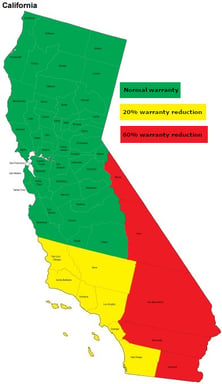 Companies like Avery Dennison take this concept to another level, even denoting separate zones within specific American states. If you live in the north of California for example, you are eligible for a full warranty, but if you live in a yellow zone it’s a 20% warranty reduction, whilst a red zone is 60%.
Companies like Avery Dennison take this concept to another level, even denoting separate zones within specific American states. If you live in the north of California for example, you are eligible for a full warranty, but if you live in a yellow zone it’s a 20% warranty reduction, whilst a red zone is 60%.
Solar Radiation
Solar radiation in the form of UV light is a big threat to the longevity of your vehicle wrap as it causes fading, cracking and peeling over time. UV light varies in intensity across the globe depending on how close you are to the sun.
There are local factors such as altitude, or the health of the ozone layer to take into account, but in general: the closer you are to the equator, the closer you are to the sun.
Companies such as Orafol take this into account when drawing up their zone maps, as you can see below. Zone 3, the red area, roughly lines up with the equator, with some regional variance.
Apart from keeping your vehicle out of the sun you can also opt for an extra layer of protection in the form of paint protection film or a vinyl friendly wax polish. This will help preserve the life of your wrap.
Angle of Exposure
Even the angle of your vehicle graphics relative to vertical (0°) affects your durability. The more horizontal your vehicle graphics are the more time they will be exposed to solar radiation relative to a more vertical facing graphic. As a result horizontal facing graphics generally have half the maximum expected service life of a vertical graphic.
Vertical is usually defined as any angle within 10° of 0 in your product warranty document. A non-vertical angle ranges from 10° to 85° and a horizontal angle is roughly 85-90° though this will vary slightly policy to policy.
A non-vertical or horizontal angle will usually cut the expected performance life of a product in half.
Check out this zone and angle of exposure chart from Avery Dennison above. This is a rough guide that you can cross reference with your product's expected performance life.
To put this in perspective, if you use Black & White Avery Dennison Supreme Wrapping Film in the UK (a Zone 1 country), you can expect 12 years from the vertical faces of the wrap and just 6 from the horizontal or non-vertical faces. If you lived in a zone 3 area such as Arizona, you can expect 8 and 4 years respectively.
Altitude
In regions at a high elevation relative to sea level the air is thinner and there is generally less of it between you and the sun. This means the intensity of solar radiation, specifically ultraviolet (UV) light is much higher as less of it is reflected by the atmosphere. With every 1000 metre increase in altitude, UV levels increase by 10-12%.
As a result your wrap is likely to fade, crack or peel at a much faster rate than a wrap kept closer to sea level. Companies have varying policies to account for this, but 3M will actually void your warranty if you keep your vehicle wrap higher than 1500 metres above sea level.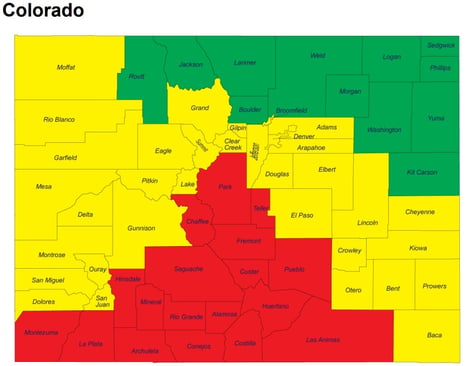
This is something to keep in mind if you live in a mountainous or high altitude location. If you live in Colorado for example, which has an average elevation of 2074 metres, your wrap is likely to fade, crack or peel much faster than if you lived in Oregon.
You can actually see altitude factors reflected in Avery’s Colorado warranty map. Low altitude areas are green, but the moment you start getting closer to higher or mountainous areas, things change.
You definitely have a disadvantage if you live at a higher elevation, but at least Avery won't void your warranty entirely!
Abrasive Particulates
Another factor to take into account with climate apart from temperature and radiation is particulates. Debris in the form of excessive sand, dust or road salt can be quite abrasive and erode or scratch your vinyl over time.
Rinsing your vehicle regularly with a hose is a good idea. Make sure you do that before applying a sponge, as debris can become trapped in the cavities that you then rub into the vinyl surface, damaging it further.
Pollutants
Pollutants and particulates are found in much higher concentrations in urban and congested areas, reducing the expected durability of a vinyl wrap product. Horizontally angled body panels on a vehicle are particularly at risk as they trap contaminants on the surface of your vinyl.
Damage caused by pollutants will come under general wear and tear, so it is not something you can make a claim on under standard product warranty.
Aftercare
Failure to look after your vehicle wrap will reduce the expected performance life, so proper aftercare is essential. Regular washing is key, though if you keep your vehicle inside you will need to do this less often.
The best way to keep your wrapped vehicle clean is to first rinse it thoroughly with cold water and then wash the wrap by hand with a soft, clean sponge.
For more aftercare tips, read our vehicle wrap aftercare guide. You will learn the best way to wash your wrapped car or van, how to remove difficult contaminants such as droppings, dead bugs etc, and how to wax or pressure wash your wrapped vehicle.
What are my next steps?
Now that you know a little more about how vehicle wrap durability works, you might be wondering how that affects your warranty? Check out our vehicle wrap warranty guide to learn more about how vehicle wrap warranty policies actually work.



